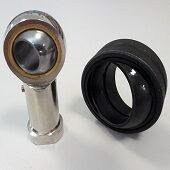What are plain bearings and what is their purpose?
Plain bearings (e.g. bushings, ball joints) facilitate linear movement between two parts.
Plain bearings consist of metal, plastic, or fiber-reinforced composite sleeves that reduce vibration and noise by absorbing friction between two moving parts in a sliding motion.
Plain bearings have many advantages, including lower cost, less maintenance, and a large reduction in low-speed operation. The performance of sliding bearings is also characterized by a higher load capacity, especially due to their larger contact zone. Plain bearings with conformal liners compensate for misalignment problems and vibration damping.
Plain bearings can be made of bronze, steel or stainless steel. Brass bearings and plastic sleeve bearings are also manufactured for certain applications. A common type of plain bearing that works well in applications that require constant lubrication are bronze bearings, which sometimes include grease plugs (PTFE or graphite) to solve lubrication problems. Another material used for light and medium applications is called oil-impregnated bronze sleeve bearings, which contain pores that absorb the oil that is released under force and then absorbed back into the bearing after the force is removed.
The two general designs of sleeve bearings are flanged and cylindrical bearings. Flanged sleeve bearings consist of a protruding flange at one end of the sleeve, while cylindrical roller bearings have straight outside and inside diameters and are flush inside the housing.
What is the purpose of the plain bearing?
Simply put, plain bearings facilitate movement between two parts, reduce friction and absorb vibration. They have a high load capacity, so they are suitable for many demanding applications.
Robust plain bearings withstand high loads and high temperatures with incredibly low wear. Their contact surfaces have high impact resistance and can compensate for the displacement of other components.
Where are plain bearings used?
Plain bearings are incredibly versatile and can be used in many applications. They can be used to facilitate different groups of movements:
- Rotating movements
- Linear movements
- High frequency oscillating movements
They are usually found in pivot points and as a result are widely used in the automotive, engineering and household goods industries. In the automotive industry, they provide rotary linear motion for hinges, seat adjustment mechanisms and steering wheels.
Types of plain bearing design and material
Plain bearings have a few basic types and many material options. The most common type of plain bearings is the flanged sleeve bearing. The flanged sleeve bearing absorbs both axial and radial loads. Alternative options include cylindrical and push-disk designs. In the case of higher side loads, the combination of a thrust washer and a cylindrical bearing is a good alternative.
Bearings can be made of several materials. These include metal, bimetal, ceramic, stone, graphite, composites and plastic. The function of a sleeve bearing is determined by the choice of material, as the material determines the strength, elasticity, coefficient of friction, etc.
Cast or sintered metal bushings have a low coefficient of friction under hydrodynamic conditions when used with hard steel shafts, but severe chatter precludes many applications. Injection molded plastic is a low-cost option and comes in many shapes and sizes.




Megjegyzések
Megjegyzés küldése